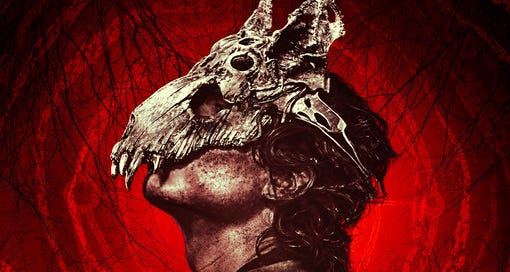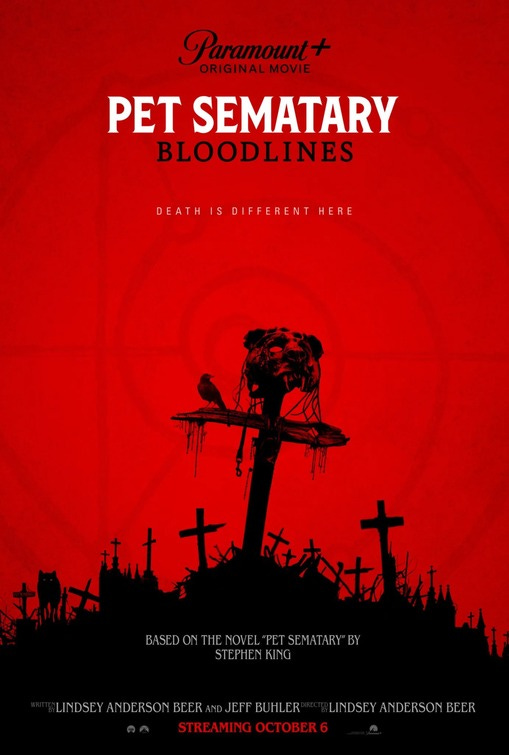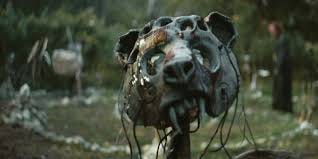2023's Pet Sematary: Bloodlines Answers All the Questions No One Had About the Oddly Deathless Franchise
Sometimes, dead is better.
The 1983 Stephen King novel Pet Sematary holds special interest for Guillermo Del Toro because, at its core, it is a story about grief —a sadly universal theme.
Pet Sematary is about a loss so massive and a pain so great that it leads misguided souls in the unmistakable direction of damnation and insanity. It’s about mourners willing to cross lines that should never be crossed for the sake of just a little more time with a loved one.
Del Toro told The Kingcast podcast, "You know the novel that I would have killed to adapt, and I know there are two versions of it, and I still think maybe in a deranged universe, I get to do it again one day, is Pet Sematary. Because it not only has the very best final couple of lines, but it scared me when I was a young man. As a father, I now understand it better than I ever would have, and it scares me a hundred times more."
If Guillermo Del Toro had gotten an opportunity to direct a classy, atmospheric adaptation of Pet Sematary, I suspect that I would have been moved deeply. The two greatest traumas I’ve endured are the death of my dog a few years back and the loss of my dad yesterday.
I am emotionally raw. Death is on my mind. My defenses are down. Yet I still experienced next to nothing watching 2023’s Pet Sematary: Bloodlines, other than a vague sense of annoyance at how utterly arbitrary it felt.
King dreamed up a premise you can find in forty percent of all E.C. horror comics—sinister figure comes back from the grave twisted, tormented and hungry for blood—added pets and Native American burial grounds to the mix and came up with a premise so sturdy it led to a bestseller, surprise hit 1989 adaptation written by King himself, a less successful sequel in 1992’s Pet Sematary Two, a dour remake in 2019 starring Jason Clarke, Amy Seimetz and John Lithgow and finally a prequel in 2023’s Pet Sematary: Bloodlines.
Bloodlines provides answers to questions that nobody is asking. How did Jud Crandall, the Frankenstein-looking motherfucker that Fred Gwynne played so unforgettably in the original film, learn about the Pet Semetary and its sinister secrets? Why didn’t he ever leave his hometown and live somewhere less evil? What happened to turn a sleepy small town into a haunted deathtrap?
Pet Sematary: Bloodlines begins in 1969. Nice. A young Jud (Jackson White) is eager to avoid the draft, serve humanity, and leave his godforsaken small town by signing up for the Peace Corps. A different, darker destiny awaits the poor man, however.
David Duchovny has the kind of role here that makes you question not only his judgment but also his choice of agents. He puts his radiant smile into cold storage to play Bill Baterman, a small town schmuck who isn’t about to let his soldier son Timmy’s death in Vietnam keep them from having a relationship and being able to shoot the shit.
In an act of staggering bad judgment, Bill buries his boy in the Pet Sematary. He comes back from the dead, but he’s changed. For starters, he’s violently insane and kill-crazy.
He’s not subtle or understated in his villainy. He might as well have glowing red eyes, horns, and a tail. If there was any good in the boy to begin with, it died alongside the rest of him during his first death.
Pet Sematary and its remake at least gave us an opportunity to know its zombies before they’re buried in the titular haven for dead pets. They are not masterpieces of subtlety and understatement, but they make us care because the victims-turned-monsters are children and animals. Their lives consequently have more value than those of adult humans.
The first semetary-fueled ghoul is a young man whose father disastrously uses dark magic to resurrect him. We don’t know Timmy as anything but an undead monster. There is no innocence to corrupt, no purity to pervert.
When he worked for the US military, li'l Timmy was encouraged to kill. He received shiny medals for eliminating the enemy in Nam, but stateside murder is discouraged for everyone but law enforcement.
Jud is alarmed that his pal has transformed into a murderous, cannibalistic monster from beyond the grave with sinister telekinetic gifts. He’s uninterested in conversations or relationships, but nevertheless seems to know everyone’s dark secrets.
Timmy’s sad fate connects Bloodlines to King’s original novel, where Timmy is the lead character in a cautionary tale, an elderly Jud tells a grief-stricken Louis in a failed attempt to keep him from following in his footsteps and messing with the forces of life and death.
The movie's main monster isn’t a protagonist in King's novel: he’s an anecdote. That's all he is. There’s nothing to him. Duchovny doesn’t seem distraught or mad with grief so much as mega-bummed.
Jud wants to leave his cursed small town, but something refuses to let him escape —something evil, something ancient that implicates the whole town.
Henry Thomas, who has picked up a lucrative sideline appearing in Stephen King adaptations, many directed by Mike Flanagan, the director of the just-released The Life of Chuck, plays Jud’s respectable doctor father, who uses his influence to prevent him from being drafted but cannot keep him completely out of harm’s way.
The Pet Sematary and its unholy powers are a dark secret that the town elders share. In that respect, it’s not unlike how the concerned, murder-crazed killer parents of Springfield somehow manage to keep their progeny from knowing about the whole kerfuffle involving Freddy Kruger.
Pet Sematary was inspired, in part, by the classic short story “The Monkey’s Paw.” The endlessly recycled terror tale similarly revolves around grief-mad parents so intent on having their dead son back that they unwillingly unleash something evil and unholy.
Bloodlines leans into the idea that the land itself is cursed, an unholy place that tricks the heartbroken and despondent into committing unforgivable transgressions, into playing Dr. Frankenstein, if not God Herself.
Much of the film’s third act is devoted to townspeople wandering around in a dark so all-encompassing that it’s difficult to even see what’s going on. It’s also impossible to care.
The tawdry terror tale of Timmy, undead Vietnam veteran, links this wildly unnecessary exercise in cynical brand extension to King’s novel, as does the franchise’s official catchphrase.
Our hero’s dad and our hero both get an opportunity to say, “Sometimes, dead is better.” Those are words Pet Sematary fans love to hear.
It’s hard to deny the truth of Jud’s famous quotation, particularly since it applies to the franchise itself. Pet Sematary didn’t need a sequel or a remake. It sure didn’t need a prequel to a remake.
It’s hard to deny the fundamental power of King’s story, but it doesn’t need to be a franchise. With film series, as well as undead corpses, sometimes dead truly is better, but I don’t think we’ve seen the last of this bleakest of funny animal stories.












Somehow, every Pet Sematary adaptation has managed to lose or ignore the actual terror and grief of the novel. Maybe, just maybe, all of these attempts at turning the story into a pulpy B-movie are misguided. I would've loved to see what Guillermo Del Toro, or even Mike Flanagan, could have done with a more sober interpretation of the material.
This also kind of sounds like Bob Clark's early film DEATHDREAM, about a Vietnam Vet who's killed overseas, but his mother (unintentionally) wishes him back to life, and he returns as an odd, shambling ghoul who everybody just assumes "is a bit different because of the War".
It's an interesting, if cheap and flawed, mix of "The Monkey's Paw" with Vietnam Vets suffering from PTSD.